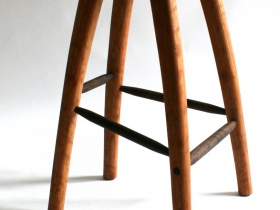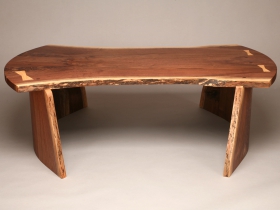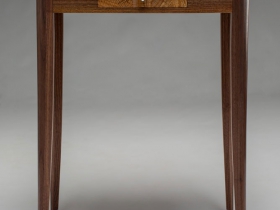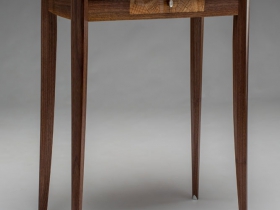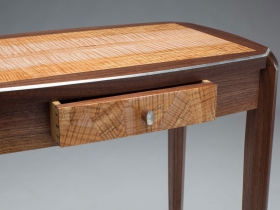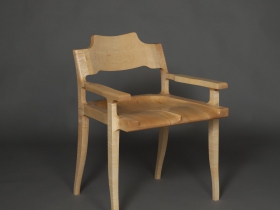The Surprising Splendor of “Urban” Wood
An exhibit of wood artists makes you rethink the wood that lines our streets and shades our homes.
“Urban Wood Encounter,” through January 25 at the Lynden Sculpture Garden, is frankly, a wonderful surprise, delivering more than you might imagine from its enigmatic title. The exhibit features artfully crafted fine furniture by 13 woodworkers from the greater Milwaukee area: The work is beautiful and the exhibition is smartly organized to draw great delight and meaning from an often overlooked genre of functional art.
The works are dedicated to the use of materials normally thrown into a landfill, to the “urban wood” – such as elm, ash, walnut, maple, locust and oak — “that lines our streets, shade our homes, and define our parks,” as the exhibition notes explain. Often these trees succumb to disease and blight and often discarded and wasted. Dwayne Sperber, the exhibit’s co organizer, founded Wudeward Urban Forest Products to repurpose these woods and advocate for their use. (Lynden executive director Polly Morris is the show’s other co-organizer.)
I was struck by two distinct approaches in these works. One group of artists are delicate and almost animated in their use of elegant, slender legs and juxtaposition of different woods accenting subtle colors, textures and patterns. A fine example of this is “Ariel Ballet,” by Charles Radtke a dainty side table of walnut and maple whose beveled edge is finished with silver leaf. And “Skeletable,” by Lisa Ehrmantraut Brobst, uses curving legs to support a spine-like structure on which a plate glass top rests.
Kevin Giese’s work, “Elm Cabinet,” uses elm, maple and sassafras to create a lovely cabinet, tall and simple with a curved flat crown. A mysterious opening at the top adds an Asian touch to this deceptively simple piece. As with other works here, the joinery seems magical; Giese says this style, which mostly notches together the wooden parts without nails or the like (and hides those that are used), is based on centuries-old Chinese and Korean traditions.
The second type of works here are much more straightforward, using the wood as though just cut down from the forest. “Tea Ceremony” by Dan Barsch, is a massive section of tree trunk with a highly polished surface for the table, surrounded by delicate little stools, the kind of naturalistic furniture you might imagine in Peter Rabbit’s subterranean hutch. These solid, large chunks of wood, as if from a freshly felled tree, on closer inspection combine a highly polished surface with subtle butterfly joints; the net effect is functional as well as beautiful, in contrast to the rough brutality of raw bark.
Aris Georgiades’ “Saved” is a zig zag chair subtly reminiscent of a constructivist composition, but executed in a smoothly textured manner in which the natural coloration of the wood — a golden locust with a naturally occurring white stripe accenting the perimeter — contrasts to the rough bark on the sides of the piece. The chair is attached to a plank/ base that ends in a block oak footstool on wheels which moves along the base. Most ingenious!
The exhibit is complimented by several prints by Alexander Calder and a Karl Priebe water color. Also, in the reception area is a long vertical piece in steel and purple plexiglass by Donald Judd while the front porch has a Barabara Hepworth sculpture, both works from Peg Bradley’s collection at the Milwaukee Art Museum. (She also, of course, collected all the fabulous works in the Lynden Sculpture Garden.)
Ever mindful of the community and possibilities for outreach, Morris has also created an “Encounter Space” on the facility’s porch which has functional, modular pieces by design students which will be reconfigured throughout the exhibit for classes, lecture, and demonstrations.
Finally, I could not help notice the wooden bench by the fireplace commemorating the wedding day of Peg and Harry Bradley, and also the year they purchased the property and named it “Lynden”. It reminds us that this was their home and they loved nature and art, both reflected so beautifully in this exhibit.
“Urban Wood Encounter” Gallery
Art
-
Winning Artists Works on Display
 May 30th, 2024 by Annie Raab
May 30th, 2024 by Annie Raab
-
5 Huge Rainbow Arcs Coming To Downtown
 Apr 29th, 2024 by Jeramey Jannene
Apr 29th, 2024 by Jeramey Jannene
-
Exhibit Tells Story of Vietnam War Resistors in the Military
 Mar 29th, 2024 by Bill Christofferson
Mar 29th, 2024 by Bill Christofferson
Review
-
Ouzo Café Is Classic Greek Fare
 May 23rd, 2024 by Cari Taylor-Carlson
May 23rd, 2024 by Cari Taylor-Carlson
-
‘The Treasurer’ a Darkly Funny Family Play
 Apr 29th, 2024 by Dominique Paul Noth
Apr 29th, 2024 by Dominique Paul Noth
-
Anmol Is All About the Spices
 Apr 28th, 2024 by Cari Taylor-Carlson
Apr 28th, 2024 by Cari Taylor-Carlson


